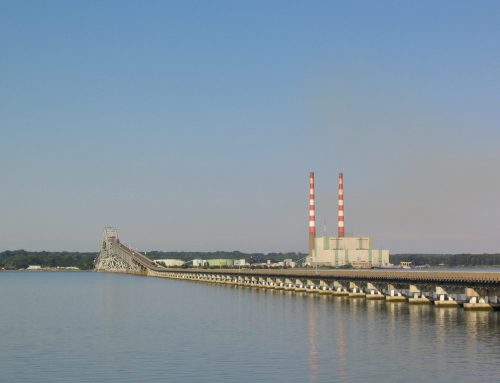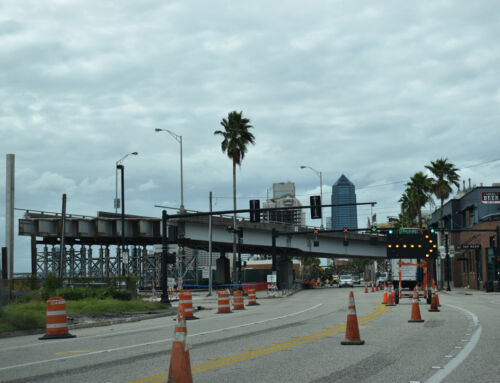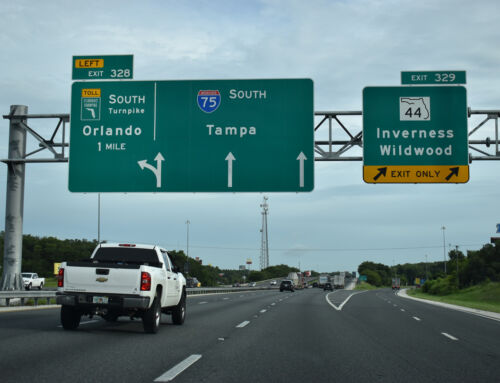Interstate 10 drivers have one less issue to worry about when traveling through the Pensacola, Florida area now. Crews recently finished work on the first of two replacement spans for the Hurricane Ivan-damaged bridges over Escambia Bay. The new span, situated just south of the original bridges, currently carries two lanes of traffic in both directions. That is a temporary arrangement as construction workers continue to build the future westbound-only span just to the north. At the same time, demolition and removal of the original twin bridges is underway.

Two segments of temporary metal decks were used on the eastbound span in places where original deck segments could not be salvaged due to irreparable damage. A similar configuration is found along Interstate 10 over Lake Pontchartrain due to the storm surge of Hurricane Katrina. Photo taken 11/23/06.

A loud cheer was heard from this perch along U.S. 90, high above Escambia Bay, from crews nearby who perhaps poured the final batch of concrete for the new Interstate 10 deck. Photo taken 11/25/06.
Cars and trucks move across the new concrete Escambia Bay Bridge while contractors prepare to demolish the old spans nearby. One feature that the new bridges have that the old lacked is overhead highway lighting. Photo taken by Alan Nitzman (03/03/07).
Interstate 10 Escambia Bay Bridge Background
Hurricane Ivan made landfall in south Baldwin County, Alabama on September 15, 2004. The northeastern path of the eye wall took the hurricane center directly over Pensacola, Florida. Winds from the storm blew in such a way that Escambia Bay and its associated topography enhanced their effect. The results were storm surges high enough to topple the low lying portions of older bay bridges including the original U.S. 98 three-mile bridge and the Interstate 10 spans.
For three weeks Interstate 10 was severed with no access between Escambia and Santa Rosa Counties outside of the U.S. 90 causeway to the north. Emergency funds and construction took place almost immediately on repairing the spans to at least accommodate one lane in each direction. That occurred with the restriction that the heaviest vehicles be banned from both structurally impaired bridges and passing be prohibited on the heavily damaged eastbound span, due to the inclusion of temporary metal spans where original decking could not be salvaged. The westbound span opened within three weeks of Ivan’s landfall followed by the eastbound span on November 27, 2004.
FDOT awarded a design-build contract in January of 2005 for the construction of a permanent replacement of the damaged bridges. Work commenced soon thereafter on the new eastbound-only span while travelers labored across the restricted bridges to the north.
On December 19, 2006, area commuters and through traffic received much needed relief when the new Interstate 10 eastbound-only span opened to two-way traffic. Dubbed the “Crooked Bridge” by locals due to its dogleg and “crooked” nature, the span accommodates all traffic until November 2007 when construction may be complete on the new westbound bridge.
When complete, six lanes of Interstate 10 will span Escambia Bay on separate bridges each with 10′ inside and outside shoulders, a dramatic improvement over the original four-lane shoulder less bridges. Overall Interstate 10 grows to six overall lanes between Exit 10 (U.S. 29) and the eastern approach to Escambia Bay (mile marker 21), a needed improvement over the previous four lane capacity.
See http://www.escambiabaybridge.com for details, construction schedule, and additional photos.









Why did they make it a concrete & metal pattern?
I,ve been over this bridge
a lot.
Great pictures